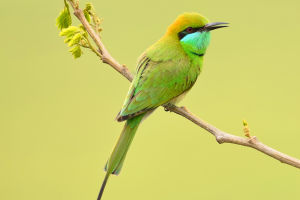Merops apiaster, is a medium-sized bird commonly found in open areas, deserts, and farmlands of Europe, Africa, and Asia. They have bright plumage with a golden head and breast and a striking yellow throat with green, blue, and red stripes on the wings and a long central tail feather on the tail.
The following are the life habits of Merops apiaster:
Diet: Merops apiaster is an insectivorous bird that feeds mainly on insects, including locusts, bees, wasps, butterflies, and dragonflies. They typically hunt in the air, fly very fast, and grab prey in their mouths before returning to their habitat to digest it.
Habitat: Merops apiaster often inhabits open grasslands, deserts, farmland, mountains, coasts, etc., and usually digs nests on the ground or near river banks.
Breeding: Merops apiaster forms small colonies during the breeding season and digs nests to build nests on the ground or near river banks. The female usually lays 2 to 3 eggs, and the male and female work together to incubate and feed the young.
Behavior: The Merops apiaster is generally a solitary bird but forms small groups during the breeding season. They are fast and usually airborne, preying on insects.
Overall, the Merops apiaster is a very beautiful and interesting bird that attracts attention with its colorful plumage and swift flight.
Interesting facts about Merops apiaster:
1. Merops apiaster is a migratory bird that flies to the Sahara Desert in Africa every autumn to spend the winter, and then returns to Europe to breed in spring.
2. Merops apiaster usually leaves some "garbage" when digging the nest, such as beeswax and small stones, etc., to reduce the humidity in the nest and provide additional structural support.
3. Merops apiaster has a special call, similar to the "papa" sound, which is used to attract mates and warn other birds.
4. The flight speed of Merops apiaster is very fast, the fastest can reach 70 kilometers per hour, even faster than some cars.
Merops apiaster contracts its throat muscles to catch prey during flight, hence the name "bee-eater".
Have you heard the story about the Merops apiaster?
Long, long ago, there was a young man named Ali who got lost in the desert. He walked for a long time, hungry and thirsty, almost unable to support himself. Just then, a Merops apiaster flew in front of him, took a bee in its beak, and put it on Ali's face.
Ali tasted the bees, which were delicious, and felt his throat moisten. After seeing Ali's reaction, Merops apiaster flew to a small river, brought back some water, and dripped it on Ali's lips.
After Ali drank the water, he felt his strength regained and moved on. For the next few days, the Merops apiaster stayed with him, helping him find water and food until he emerged from the desert.
Since then, Ali was very grateful for the help of Merops apiaster. He regarded Merops apiaster as his patron saint and told others the story about Merops apiaster, and people began to respect and protect this beautiful bird.


